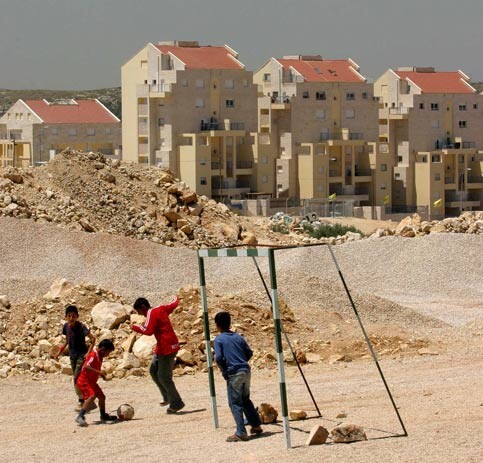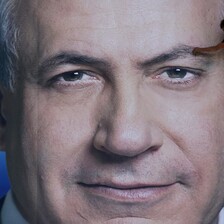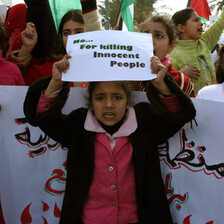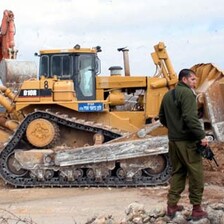
Palestinian boys play football near the Israeli settlement Kiryat Sefer, seen in background, in the West Bank village of Bilin, west of Ramallah, 23 May 2006. The settlement is being built on the village’s lands that have been cut off by the Apartheid Wall. (MaanImages/Moti Milrod)
Topography here is in constant fluctuation. From one visit to the next a whole area, or just a small street, can look completely different. In Gaza, maybe it has been destroyed or, sometimes, rebuilt.
In the West Bank, including East Jerusalem, a flow of ongoing construction manifests itself in the wall, in the illegal settlements and in the construction of the discriminatory road system.
Today, while driving through the western edges of the West Bank, we began to understand what the “forbidden roads regime” actually means — through an intricate series of road systems Israelis will travel on one set of roads while Palestinians will travel on roads built underneath them.
It is claimed that the system is designed to facilitate so-called ‘viability’ of any potential Palestinian state by making it territorially contiguous. More importantly, as Trocaire’s partner B’Tselem, the Israeli human rights information centre, say: “The Forbidden Roads Regime is based … on a racist premise, that indiscriminately harms the entire Palestinian population, in violation of their human rights and of international law.” (B’Tselem has a map of the road system here.)
Many of the roads we passed are still under construction. We drove along the Israeli-only highways and saw, to the side, dirt tracks that will be turned into small roads for Palestinians. Although we were driving through the occupied West Bank we did not see any Palestinians and we didn’t see their villages or towns. Only Jewish settlements were visible.
The view has been “sanitised” so that Palestinians are never seen, or heard.
The sandy stone of the West Bank has been carved out to facilitate the construction of the road’s system. All through our journey we knew, off to our east, only minutes away, was the hussle and bussle of Palestinian towns with their chaotic markets and their queues of yellow taxis — all of this set deep into the rolling jabels (hills) of the West Bank. But all of it hidden to our eyes.
In response to the publication of Jimmy Carter’s new book, Palestine: Peace Not Apartheid, Fr. Eoin Cassidy of the Irish Commission for Justice and Social Affairs asked in a recent Irish Times article, “Can one sustain the thesis that the restrictions imposed on Palestinian freedom of movement are progressively transforming Israel into an apartheid state? Unfortunately, I think that we can.”
The roads system is the most obvious manifestation of this thesis — discriminating, as it does, on the basis of racial and ethnic difference. Or in the words of the Rome Statute to the International Criminal Court (to which Israel is not a state party), “The crime of apartheid means inhumane acts … committed in the context of an institutionalized regime of systematic oppression and domination by one racial group over any other racial group … committed with the intention of maintaining that regime …”
And yet the word remains a controversial one. Critics say that it is inaccurate, lazy thinking that can do nothing to help the situation here or to bring everyone closer to justice or to peace.
Tomorrow morning we are heading to the town of Hebron, an astonishing place, where Palestinians live inside a system of metal cages which have been placed between the first floor of their homes and the upper floors where illegal settlers have moved in. Settlers are allowed to do as they please but Palestinians are prevented from doing anything, on the basis of their ethnicity.
To me it has more then the ring of systematic oppression and domination by one racial group over another to maintain a regime. But you can call it whatever you like.
Eoin Murray is a Programme Officer for Trocaire.
Related Links





